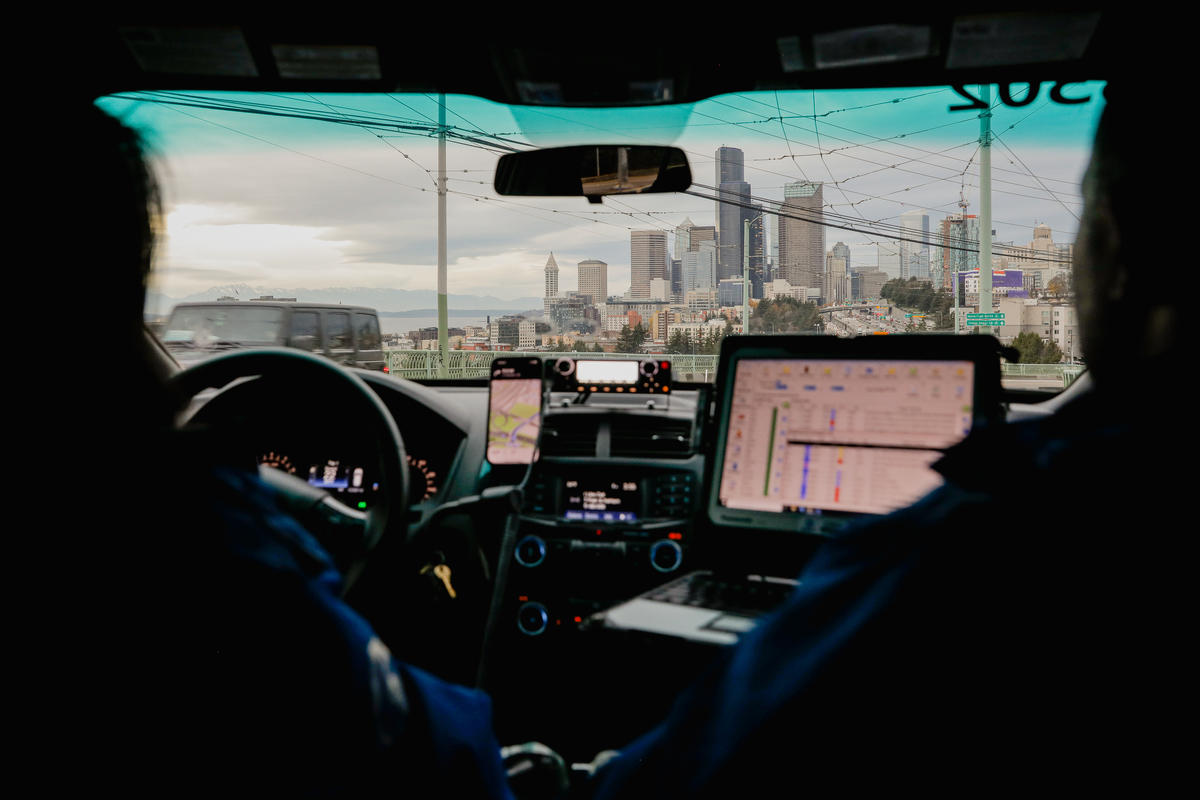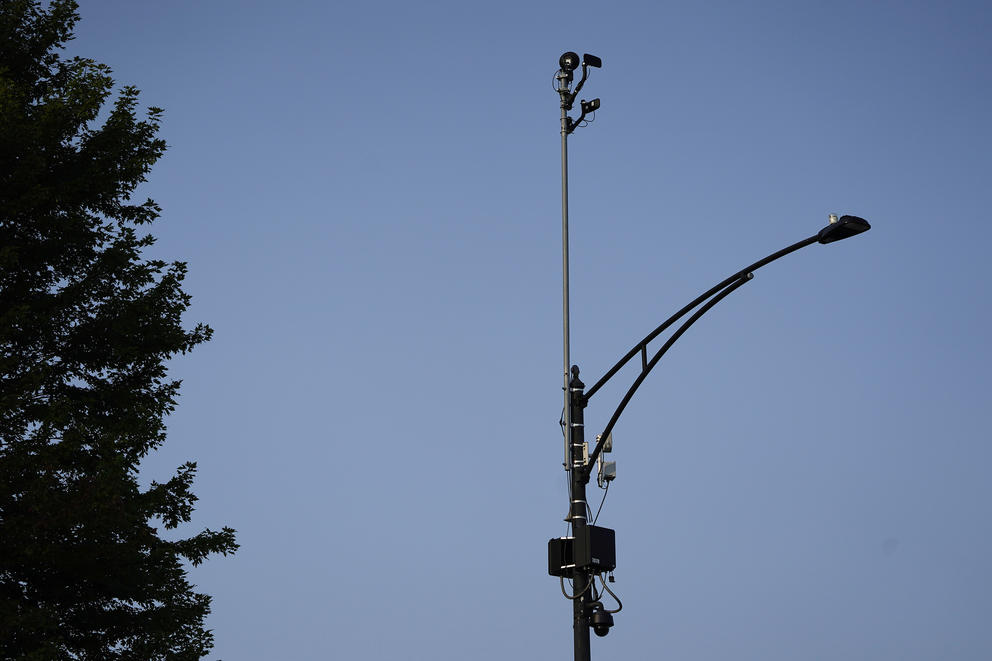The Mayor’s office released a statement to Crosscut saying that the police staffing shortage, increase in homicides and use of firearms in these cases is why it wants to try this crime prevention technology.
Along with the camera and audio systems, the pilot program will include a crime center that responds to real-time alerts.
Mayor’s office spokesperson Jamie Housen said the technology is only one of the city’s strategies to combat crime. Others include hiring more officers and adding more street lights and sidewalk cleaning.
Overall crime in Seattle decreased by 9% in 2023; however, shootings that year increased 3% over 2022, according to the Seattle Police Department 2023 year-end overview. Homicides have also increased by 23%, but the police force continues to shrink.
The state saw an overall increase in crime in 2022, the latest data available from the Washington Association of Sheriffs and Police Chiefs, with record-breaking use of firearms during violent offenses.
While ShotSpotter is one of the better-known companies, Housen said the city has not named the company’s acoustic gunshot locator system as its partner.
Areas the city plans to implement this technology include Aurora Avenue North, Downtown in the Third Avenue corridor and in Belltown.
The Seattle Police Department declined to comment on the proposed system or its plans for using it, but the debate before the City Council so far has illustrated that there are many opinions about this technology.
Among the concerns listed by community members at a public forum on the proposal: lack of information on where the technology will be implemented; the companies the city plans to partner with; and lack of outreach to community groups or neighborhoods likely impacted by the plan. They also criticized the brief time they were given to comment.
“I’m highly concerned that this technology will be solely used to further persecute, harass and mistreat the poor and marginalized in Seattle,” testified Rose King, a University of Washington biochemistry professor. “I don’t believe that we can fight gun violence with police violence.”
Erica Olson said she did not want to invest her tax dollars in ineffective technology that could lead to more biased policing and abuse. “Additionally, I’m interested to know why it was so difficult to find any information on this hearing; with that my trust in the surveillance technology being used responsibly is extremely low,” Olson said. “This meeting was not listed on the Council’s website. It was a huge pain to try to find it.”
The ACLU Washington state chapter echoed many of the community comments opposing the proposal. “It ends up draining city and police resources rather than actually helping with community safety,” said Tee Sannon, ACLU Washington technology policy program director.
Sannon said some people have shared that installing these technologies would turn areas into a “surveillance state.”
Justin Ward from DivestSPD, a local activism group advocating for abolishing the police, posed several questions about the value of implementing this technology in Seattle: “What value do we get? What does it do? Does it make us safer? Is it worth that rather large investment?”
Ward pointed out that although the pilot programs are intended to prevent crimes, technology systems respond only after a crime has occurred.
“Best-case scenario is that it helps them [police] respond quicker to shots fired, and that is going to result in more arrests? Is that necessarily what most benefits the community? I think the ideal outcome is to not have people shot at all,” Ward said.
“The best you could do is take a few people off the street, but you’re not going to actually take them and transform their lives and put them on a path where they’re going to be a productive member of society,” Ward added.
The City Council will be accepting public comment through March 22. Housen said the comment period was extended from the original deadline at the end of February because the topic was gaining a lot of public attention.
This technology in other cities
Some of these criticisms have been heard in cities that previously adopted a similar technology.
Chicago Mayor Brandon Johnson recently announced the city will not renew its contract with ShotSpotter’s gunshot detection company, SoundThinking. The company, based in Fremont, California, says around 150 cities have installed ShotSpotter and the technology has a 97% accuracy rate and a less than 1% rate of identifying false positives.
Chicago began its six-year contract with SoundThinking in 2018, and has spent a total of $49 million since placing the technology in largely Black and Latino communities in the south and west parts of the city. Chicago joins several cities that have pulled out of contracts with the gunfire detection company, including Charlotte, North Carolina; Atlanta; New Orleans; Trenton, New Jersey; and San Antonio.
Officials in those cities said they stopped using the system because it consistently misidentified fireworks or motorcycle sounds as gunshots. Chicago’s inspector general said in a report that police responding to ShotSpotter alerts rarely found evidence of a gun-related crime.
An AP investigation revealed flaws in the system after ShotSpotter was used as evidence to prosecute an innocent 65-year-old man for killing a young man in Chicago in 2020.
ShotSpotter equipment overlooks the intersection of Chicago’s South Stony Island Avenue and East 63rd Street on Aug. 10, 2021. Chicago won’t renew its contract for the controversial gunshot detection system and will end the use of ShotSpotter technology later this year, Mayor Brandon Johnson’s office announced Tuesday, Feb. 13, 2024. (AP Photo/Charles Rex Arbogast)
“I think that Seattle is in a really good position right now where we can learn from all of these cities, what has not worked for them and not waste public funds, trying the same things that we already know have not worked,” said former Seattle City Councilmember Lisa Herbold.
Herbold, who chaired the Council’s Public Safety Committee, opposed ShotSpotter and this kind of technology during her time on the Council.
“One of the mantras of Mayor Harrell that I really love is this idea of One Seattle,” Herbold said. “And I don’t think this is moving forward in that spirit.”
She said the city should instead prioritize faster police response times or focus on programs like the Seattle Community Safety Initiative, which invests in organizations that focus on disrupting cycles of violence in communities in the Central District as well as West and Southeast Seattle.
“People think of me as being a champion of civil rights and I am, but with my criticism of this technology, I’m intentionally taking off my civil liberties hat and putting on a hat that is about focusing our resources on public safety issues in a strategic way that makes good sense and use of limited resources,” Herbold said.
A study from the Journal of Experimental Criminology looked at the efficacy of pairing a camera system with a different gunshot detector technology, like the system Seattle is proposing, in high-crime areas in Philadelphia, and found a 259% increase in reported gunshots but no increase in confirmed shootings.
The alerts did increase the workload of police going to places where no evidence of a shooting had occurred, according to the report.
Researchers found that in the first months of implementation, false alarms accounted for more than 80% of the detected sounds, and some studies have shown that these numbers do not improve over time.
In 2012 the Philadelphia Police Department established a real-time crime center, where staff receive 911 calls and can look at live monitoring cameras of an area to see when a crime is occuring, or capture evidence after it has occurred.
Denver renewed its five-year contract with ShotSpotter in 2022. The Denver Police Department said it received nearly 5,000 ShotSpotter alerts in 2023, resulting in 122 arrests and 104 recovered firearms.
Denver Chief of Police Ron Thomas said ShotSpotter has helped officers reach victims quickly and get them treatment, as well as take suspects into custody and recover evidence.
Thomas said mixed opinions on the technology remain in Denver. Some people feel they are over-surveilled, while others are thankful the technology exists.
While ShotSpotter in Denver is not used in tandem with a specific camera system, like the one proposed by Mayor Harrell, Thomas said they sometimes use footage from surveillance and traffic cameras near areas where ShotSpotter is located to determine where shots were fired and take measures to reduce gunfire in those areas.
He acknowledged there are kinks in the system, with officers sometimes having to respond to false positives like fireworks, garbage disposals or other loud noises, but says officers go through a process to identify if what was heard is gunfire, like a neighborhood survey where people can tell police what they heard or saw.
“There are very infrequent occasions where they get it wrong,” Thomas said. “We have to use the ground truth to notify them [the company] that a false positive came through.”
How the technology works
For ShotSpotter, microphones are spread around an area. When loud sounds that resemble gunfire are detected, they calculate the sound’s location, said Thomas Chittum, senior vice president of forensic services at SoundThinking.
Company employees filter the sounds to determine if they are gunshots; if they are, alerts are sent to police. Chittum said this allows police to respond sooner to incidents and let communities know law enforcement are doing their jobs.
He believes it is a mischaracterization to say that a lot of cities canceled their contracts, when it was only a handful.
“What they should look at instead is the very large number of customers that we do have that do renew, that expand their coverage or that acquire the system because they know that it will help them do a better job of responding to gunfire in their areas,” Chittum said.
Chittum said using ShotSpotter with a proposed camera system is an effective strategy to end gun violence and build strong connections with the community.
“The fact of the matter is there’s no single thing that can singlehandedly tackle gun crime,” Chittum said. “It really does take a layered approach.”
What the research says
Various independent studies have shown the technology fails to accomplish its objective. A study from 1999 to 2016 across 68 large U.S. metropolitan counties said ShotSpotter had no significant impact on firearm-related homicides or arrest outcomes.
Researchers said the annual cost of gun violence to the U.S. economy is around $229 million. ShotSpotter’s fees for large cities like Chicago and New York range from $3.9 to $5.4 million a year. The study concluded the technology is only adding to the cost of gun violence in the nation, instead of reducing it.
“Unlike public policies that take time and political will to implement, ShotSpotter is available for purchase, and its implementation is dictated by a municipality’s willingness to pay,” the researchers wrote.
ShotSpotter costs $65,000 to $90,000 per square mile per year, along with a $10,000-per-square-mile one-time service fee.
The Washington State Institute for Public Policy has kept track of the costs and benefits of public policy programs since the 1990s, and a 2015 review of the research found crime prevention programs at the youth and adult level to be more effective than using technology like CCTV to reduce crime.
Instead, the report said using cameras in high-crime areas merely increased the chances that offenders would plead guilty after a crime occurred, instead of preventing it from happening. While this data has been available for decades, the study said its cost-benefit analysis is underused in the study of crime prevention.
This story has been updated to note the extension of the public comment period.




